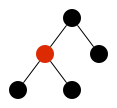Homework 1: Scheme and induction
- Due: 01/25 at 11:55pm
- Points: 15 (each question 5 points)
Please prepare your solution for problem 1 as a .scm file and your answers to problems 2-3 as a PDF file (scanned handwriting is okay, but no .doc or .docx, please). Submit both files in Sakai.
1. Caesar ciphers
This exercise is a refresher in Scheme, particularly in using higher-order functions and lexical scoping.
The Caesar cipher was used by Julius Caesar to encrypt his private letters (Suetonius Vita Divi Iulii 56.6). A Caesar cipher with a shift of k replaces the i’th letter of the alphabet with the (i + k)’th letter of the alphabet (mod 26). For example, a Caesar cipher with a shift of −3 would change ECCE to BZZB. In this problem, you’ll implement this cipher in Scheme.
Install Guile. On
student0x.cse.nd.edu, it’s installed at~dchiang/Public/guile/bin/guile. To enable editing and history, create a file called~/.guilewith the expressions(use-modules (ice-9 readline)) (activate-readline)Write a function called
caesarthat takes no arguments. It should choose a random number k between 1 and 25 (inclusive) and return a pair (cons) of functions, one which encodes strings with a shift of k and one which decodes strings with the same shift. Assume that strings use only uppercase letters. For example,> (let ((encdec (caesar))) (let ((encode (car encdec)) (decode (cdr encdec))) (encode "ECCE"))) "YWWY"(but since the shift is random, you might get a different result). And encoding then decoding should yield the original string:
> (let ((encdec (caesar))) (let ((encode (car encdec)) (decode (cdr encdec))) (decode (encode "ECCE")))) "ECCE"It should be possible to create multiple encoder/decoder pairs at the same time. (In other words, don’t store k in a global variable.)
Try to make your encoder and decoder run in O(1) space. It’s not a requirement, but it’s good functional programming practice.
The following Scheme functions should be handy:
(random n)gives a random integer between 0 and n − 1 inclusive. (This function is part of Guile; other Schemes might be different.)(modulo n m)is the same as Python’s%operator. (It behaves differently from C/C++’s%for negative numbers.)string->listandlist->stringconvert strings to lists of characters and vice versa.char->integerandinteger->charconvert characters to integers and vice versa. Note that the letterAconverts to 65.
2. Red-black trees: definition
This exercise and the next are for practicing the style of inductive definitions and proofs used throughout the book.
Here’s a definition of binary trees with nodes that are colored either red or black:
t1 bintree t2 bintree
——————————————————————— c ∈ {red,blk}
c(t1,t2) bintree
————————— c ∈ {red,blk}
c bintreeThis definition represents trees as terms. For example, the tree in Figure 1 is represented as blk(red(blk,blk),blk).

- Modify the above definition into a definition of the judgement
t rbtreethat holds iff the colors satisfy the rules for red-black trees:
- The root is black.
- The leaves are black.
- If a node is red, then both its children are black.
For each node, there is a number b (called its black-height) such that every path from the node to a leaf has exactly b black nodes.
Hint: First define the judgement
t rbtree(c,b), which holds ifftis a red-black tree with root colorcand black-heightb. (For this “helper” judgement, we suspend the requirement that the root is black.) Then definet rbtreein terms oft rbtree(c,b).
- Write a derivation tree that shows that the tree shown in Figure 1 is a red-black tree.
3. Red-black trees: height bound
Define the height of a tree to be the maximum number of edges in a path from root to leaf. (Yes, it’s strange that black-height counts nodes but height counts edges.) You learned in Data Structures, but may not have proven, that the height of a red-black tree is O(log n), which makes them good for implementing dictionaries.
Prove, by induction(s) on the structure of derivations, that a red-black tree with n nodes has height at most 2 log2(n + 1) − 2. Hint: Do this in three steps:
Prove that if
t rbtree(c,b), thenthas n ≥ 2b − 1 nodes.Prove that if
t rbtree(c,b), thenthas height h ≤ 2b − 1 if c is red, and h ≤ 2b − 2 if c is black.Conclude that h ≤ 2 log2(n + 1) − 2.
Note: This is the last time you will see a logarithm in this class!